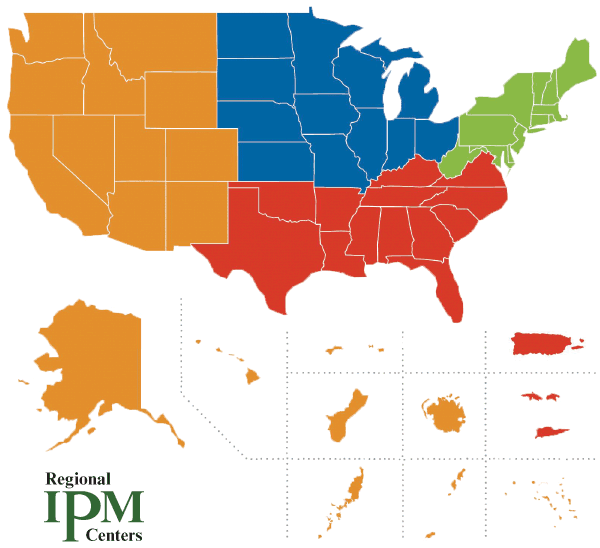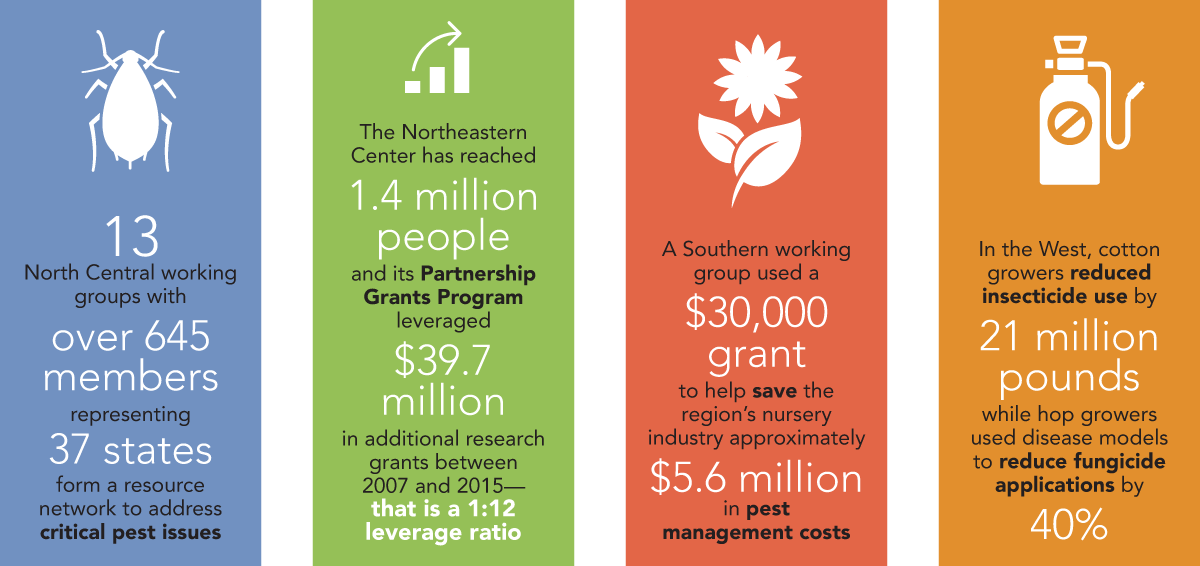The IPM Centers: National Pest-Management Priorities at a Regional Level
 |
|
Map of the regional IPM centers. |
Supporting IPM research and implementation through outreach and partnerships
The National Institute of Food and Agriculture at the U.S. Department of Agriculture (USDA-NIFA) provides funding for four regional integrated pest management (IPM) centers that collectively serve the entire United States.
That’s one center for each of the agency’s four administrative regions—north central, northeastern, southern, and western. The regional focus reflects the sheer size and geographic, climatic, and agricultural diversity of the United States.
Better Pest Management through Coordination and Collaboration
The regional centers foster the development and adoption of IPM, a science-based approach to dealing with pests—one that provides economic, environmental, and human-health benefits. While IPM isn’t opposed to pesticides, it discourages resorting to them as a default, one-size-fits-all solution, and promotes a systematic approach and use of more sustainable methods whenever possible.
USDA-NIFA funds four regional IPM centers that collectively serve the entire United States.
The centers engage with stakeholders in agricultural, urban, and rural settings who work with them to identify and address regional priorities, whether for research, education, or outreach.
The centers also work with state IPM programs, which, by nature, are charged with narrower and more specific purviews; but because pests do not concern themselves with political boundaries, the centers provide vital coordination and facilitate collaboration throughout their multistate regions.
Similarly, but on a larger scale, NIFA maintains a National IPM Road Map that it updates, as needed, to reflect the ever-evolving realities of IPM. While each region has its unique agricultural, urban, and rural considerations and pest threats, the Road Map provides strategic alignment at the national level.
Center Funding and Host Institutions
The regional IPM centers provide vital coordination and facilitate collaboration throughout their multistate regions.
Each center is administratively housed at one or more land-grant universities where the center’s staff are employees of the university, an alliance that reflects each institution’s founding principles of academic knowledge for public benefit.
But the grant process is competitive: every four years, each center submits a proposal to NIFA to make a case for the work it has done—and plans to do—for its region. If another university or organization makes a compelling argument that it would be a better host institution, the award to operate a center can change.
The centers have been funded this way since they were created in 2000 as a result of the Agricultural Research, Extension, and Education Reform Act of 1998.
Each Center’s Distinguishing Focus
Because each region of the country entails its own unique considerations, the centers differ in exactly what types of programs, initiatives, and activities they support.
North Central
The North Central IPM Center’s principal focus is to serve the region’s various stakeholders through organization, communication, and funding, as they carry out the goal of responsible, efficient, and sustainable pest management. These stakeholders range from land-grant universities to commodity organizations, regulators, and professional societies. The Center’s main method of support is through its Working Group and Critical Issues grants, which help to support cooperation among diverse groups to collaboratively address a regional IPM priority.
While all regional IPM centers contribute to developing invasive species programs, the North Central IPM Center develops and administers the Pest Alert program, in which Center personnel assist in the swift creation of invasive pest guides and methods of control and prevention.
In addition to providing funding opportunities to stakeholders, the Center also works with various groups to fulfill its signature programs. These programs are determined by conducting regular needs assessments throughout the region to identify and assist underserved programs and areas. These programs also serve as a guide for the Center and its stakeholders to focus research and outreach to further the mission of IPM.
A staple program of the Center has been in tracking and reporting invasive species across the nation. While all regional IPM centers contribute to developing invasive species programs, the North Central IPM Center develops and administers the Pest Alert program, in which Center personnel assist in the swift creation of invasive pest guides and methods of control and prevention. These pest alerts are then disseminated throughout the region and to national partners.
Lastly, the Center facilitates communication with various Hatch Committees, ad-hoc groups, and other organizations in the region, providing technological and leadership services to address critical issues.
Northeastern
The Northeastern IPM Center administers the Partnership Grants Program, supporting projects that further the Center’s mission, address or identify regional IPM priorities, and benefit the northeastern region at large. Recent grantees include:
- A team of apiary inspectors conducting outreach on effective monitoring and treatment of varroa mites infesting honey bee colonies
- An effort to evaluate the effectiveness of novel IPM tools to control weeds afflicting organic grain growers
- A project to develop a user-friendly web portal, TickEncounter, a platform for combining tick-risk assessment and testing with protection outreach
In addition, the Center collaborates with partner institutions on larger projects, including the USDA Specialty Crop Research Initiative (SCRI)-funded effort to address the brown marmorated stink bug threat at a national level, and more recently, a Center-funded working group focusing on the effects of spotted lanternfly (SLF) throughout the Northeast. The SLF project was recently awarded its own SCRI grant, including partners from the northeastern and southern regions.
The Northeastern IPM Center collaborates with partner institutions on larger projects, including the USDA SCRI-funded effort to address the brown marmorated stink bug threat at a national level.
The Center facilitates interagency coordination that is vital to mounting an effective, unified response to these invasive pests.
Among its many priority areas, the Northeastern IPM Center addresses residential pest concerns by administering the StopPests in Housing Program. Focusing on improving pest control in affordable housing, StopPests operates with interagency support from USDA-NIFA and the Department of Housing and Urban Development (HUD), maintaining an assortment of expert resources and providing consultation through conferences, webinars, and free trainings for HUD-supported properties.
Southern
The Southern IPM Center provides leadership and coordination for the identification of priority IPM needs and issues through multistate and multi-organization collaboration in the 13 states and two territories that make up the southern region by facilitating communication, sharing information, and assisting in common research and extension activities.
The Southern IPM Center’s Underserved Audiences program engages specific academic audiences within communities that may have barriers to information and support due to gender, income, socioeconomic status, language, special needs/disability, literacy, ethnicity/race, and geographic location.
Through its five signature programs, including Invasive Species, Pollinator Protection, and Resistance Management, the Center embraces the need for collaboration and leveraging of resources, specifically in the southern region.
The Center’s Facilitation of Innovation Through Technology program (FITT) acts as a free technological resource for providing advice and IT infrastructure, including a platform for project management, webinar support, meeting support, communication support, and more. This serves a valuable role for the partner programs in monitoring the technology environment, identifying tools that will be useful, bringing these tools to the attention of Center stakeholders, and facilitating their use.
The Underserved Audiences program engages specific academic audiences within communities that may have barriers to information and support due to gender, income, socioeconomic status, language, special needs/disability, literacy, ethnicity/race, and geographic location, and are not currently being served by another organization. We offer support to these audiences through a grant-writing workshop and mentoring program.
Additionally, the Center has three grant programs that are available in the region.
Two grant programs, the Critical and Emerging Issues Grant and the IPM Enhancement Grant, are mechanisms to engage stakeholders and other institutions through direct funding of working groups. Both programs address challenges such as invasive species, pest resistance, and impacts resulting from regulatory actions.
The third grant offering, the IPM Data Grant, expands on the critical need for updating crop profiles and pest management strategic plans, as many of those documents in the National IPM Database are over five years old and are no longer considered “recent” by our federal partners. This fund is an open fund (available until it is depleted) for faculty interested in updating these documents.
Western
In 2019, the Western IPM Center identified nine priority areas to address to achieve its vision of “A healthier West with fewer pests.” They fund project initiation and IPM outreach and education grants, and have been a leading proponent of creating and updating pest management strategic plans because of the tremendous value they have for commodity groups in identifying pest priorities and securing additional research and funding to address them.
The Western IPM Center works closely with the Western Sustainable Agriculture Research and Education program to promote IPM as a necessary component of sustainable agriculture.
The Center works closely with the Western Sustainable Agriculture Research and Education program to promote IPM as a necessary component of sustainable agriculture and also worked with the Western Region IR-4 program, which facilitates new pesticide registrations for small-market specialty crops, to ensure the products IR-4 pursues fit well with IPM programs. They’ve been a consistent supporter of iPiPE, including iPiPE projects in five western states focusing on vegetables, wheat, urban agriculture, stone and tree fruit, cotton, and alfalfa.
The Center prioritizes showcasing all the ways IPM can be adapted and adopted to meet the pest-management needs and protect the people, environment, and economy of the vast and diverse American West.
Regional IPM Centers Infographic

- 13 North Central working groups with over 645 members representing 37 states form a resource network to address critical pest issues
- The Northeastern Center has reached 1.4 million people and its Partnership Grants Program leveraged $39.7 million in additional research grants between 2007 and 2015—that is a 1:12 leverage ratio
- A Southern working group used a $30,000 grant to help save the region’s nursery industry approximately $5.6 million in pest management costs
- In the West, cotton growers reduced insecticide use by 21 million pounds while hop growers used disease models to reduce fungicide applications by 40%
The Northeastern IPM Center promotes integrated pest management for reducing risks to human health and the environment. If republishing our news, please acknowledge the source (“From Northeast IPM Insights”) along with a link to our website.
